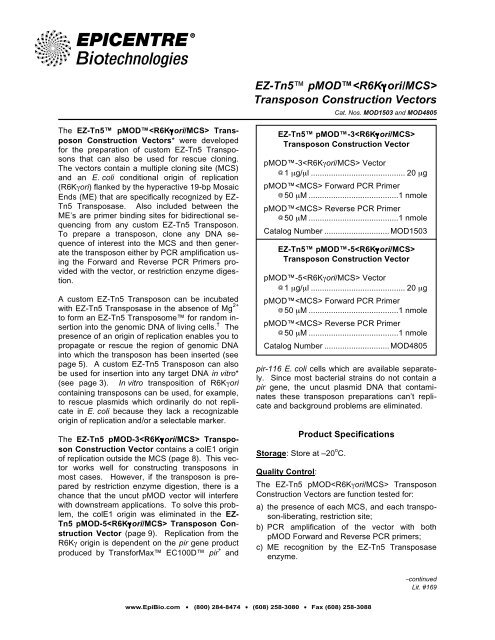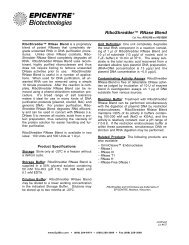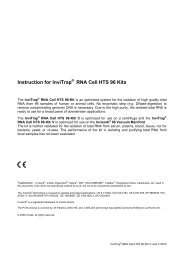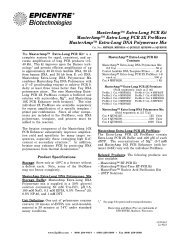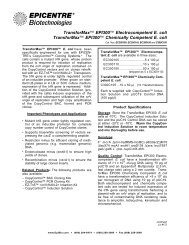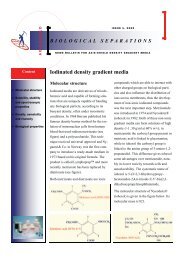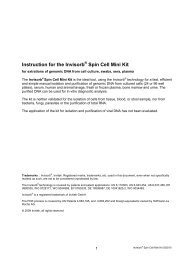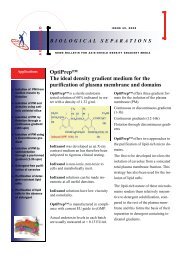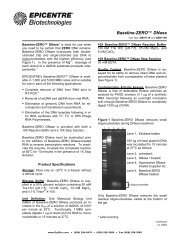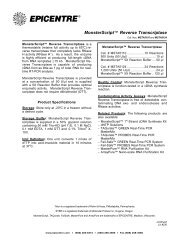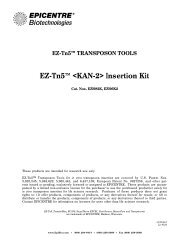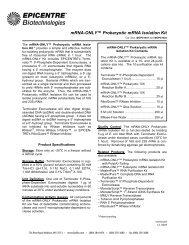Protocol for EZ-Tn5™ pMOD™ Transposon ...
Protocol for EZ-Tn5™ pMOD™ Transposon ...
Protocol for EZ-Tn5™ pMOD™ Transposon ...
You also want an ePaper? Increase the reach of your titles
YUMPU automatically turns print PDFs into web optimized ePapers that Google loves.
<strong>EZ</strong>-Tn5 pMOD<strong>Transposon</strong> Construction VectorsCat. Nos. MOD1503 and MOD4805The <strong>EZ</strong>-Tn5 pMOD <strong>Transposon</strong>Construction Vectors* were developed<strong>for</strong> the preparation of custom <strong>EZ</strong>-Tn5 <strong>Transposon</strong>sthat can also be used <strong>for</strong> rescue cloning.The vectors contain a multiple cloning site (MCS)and an E. coli conditional origin of replication(R6K ori) flanked by the hyperactive 19-bp MosaicEnds (ME) that are specifically recognized by <strong>EZ</strong>-Tn5 Transposase. Also included between theME’s are primer binding sites <strong>for</strong> bidirectional sequencingfrom any custom <strong>EZ</strong>-Tn5 <strong>Transposon</strong>.To prepare a transposon, clone any DNA sequenceof interest into the MCS and then generatethe transposon either by PCR amplification usingthe Forward and Reverse PCR Primers providedwith the vector, or restriction enzyme digestion.A custom <strong>EZ</strong>-Tn5 <strong>Transposon</strong> can be incubatedwith <strong>EZ</strong>-Tn5 Transposase in the absence of Mg 2+to <strong>for</strong>m an <strong>EZ</strong>-Tn5 Transposome <strong>for</strong> random insertioninto the genomic DNA of living cells. † Thepresence of an origin of replication enables you topropagate or rescue the region of genomic DNAinto which the transposon has been inserted (seepage 5). A custom <strong>EZ</strong>-Tn5 <strong>Transposon</strong> can alsobe used <strong>for</strong> insertion into any target DNA in vitro*(see page 3). In vitro transposition of R6K oricontaining transposons can be used, <strong>for</strong> example,to rescue plasmids which ordinarily do not replicatein E. coli because they lack a recognizableorigin of replication and/or a selectable marker.The <strong>EZ</strong>-Tn5 pMOD-3 <strong>Transposon</strong>Construction Vector contains a colE1 originof replication outside the MCS (page 8). This vectorworks well <strong>for</strong> constructing transposons inmost cases. However, if the transposon is preparedby restriction enzyme digestion, there is achance that the uncut pMOD vector will interferewith downstream applications. To solve this problem,the colE1 origin was eliminated in the <strong>EZ</strong>-Tn5 pMOD-5 <strong>Transposon</strong> ConstructionVector (page 9). Replication from theR6K origin is dependent on the pir gene productproduced by Trans<strong>for</strong>Max EC100D pir + andaa<strong>EZ</strong>-Tn5 pMOD-3<strong>Transposon</strong> Construction VectorpMOD-3 Vector@ 1 μg/μl .......................................... 20 μgpMOD Forward PCR Primer@ 50 μM ........................................1 nmolepMOD Reverse PCR Primer@ 50 μM ........................................1 nmoleCatalog Number ............................. MOD1503<strong>EZ</strong>-Tn5 pMOD-5<strong>Transposon</strong> Construction VectorpMOD-5 Vector@ 1 μg/μl .......................................... 20 μgpMOD Forward PCR Primer@ 50 μM ........................................1 nmolepMOD Reverse PCR Primer@ 50 μM ........................................1 nmoleCatalog Number ............................. MOD4805pir-116 E. coli cells which are available separately.Since most bacterial strains do not contain apir gene, the uncut plasmid DNA that contaminatesthese transposon preparations can’t replicateand background problems are eliminated.Product SpecificationsStorage: Store at –20 o C.Quality Control:The <strong>EZ</strong>-Tn5 pMOD <strong>Transposon</strong>Construction Vectors are function tested <strong>for</strong>:a) the presence of each MCS, and each transposon-liberating,restriction site;b) PCR amplification of the vector with bothpMOD Forward and Reverse PCR primers;c) ME recognition by the <strong>EZ</strong>-Tn5 Transposaseenzyme.continuedLit. #169www.EpiBio.com • (800) 284-8474 • (608) 258-3080 • Fax (608) 258-3088
EPICENTRE<strong>EZ</strong>-Tn5 pMOD<strong>Transposon</strong> Construction VectorsProduct SpecificationsQuality Control (continued):Additionally, each primer is tested in a DNA cyclesequencing reaction using the SequiTherm EX-CEL II DNA Sequencing Kit and the pMOD vector as template.Reference:1. York, D. et al., (1998) Nucl. Acids Res. 26,1927.Related Products: The following products arealso available:– <strong>EZ</strong>-Tn5 Transposase– <strong>EZ</strong>-Tn5 pMOD Forward andReverse Sequencing Primers– Trans<strong>for</strong>Max EC100D pir+ ElectrocompetentE. coli– Trans<strong>for</strong>Max EC100D pir-116Electrocompetent E. coli– <strong>EZ</strong>-Tn5 pMOD-2 <strong>Transposon</strong>Construction Vector– <strong>EZ</strong>-Tn5 pMOD-4 <strong>Transposon</strong>Construction Vector– APex Heat-Labile Alkaline Phosphatase– Fast-Link DNA Ligation Kits– T4 DNA Ligase– Colony Fast-Screen Kits– MasterPure Nucleic Acid Purification Kits– End-It DNA End-Repair Kit<strong>Protocol</strong>sI. Cloning into an <strong>EZ</strong>-Tn5 <strong>Transposon</strong> Construction VectorCreating a custom <strong>EZ</strong>-Tn5 <strong>Transposon</strong> requires that you clone your DNA fragment of interest into theMCS of the pMOD Vector. A map of the MCS and sequencing in<strong>for</strong>mation are provided later in thisdocument to assist in development of a successful cloning strategy.Please consult a general molecular biology reference [e.g. Maniatis, T., et al., (1982) Molecular Cloning:A Laboratory Manual., Cold Spring Harbor Press, Cold Spring Harbor, N.Y.] <strong>for</strong> recommendations onrestriction digests, dephosphorylation of vector and ligations. EPICENTRE offers the Fast-Link DNALigation and Screening Kit <strong>for</strong> efficient ligation and recombinant screening, APex Heat-Labile AlkalinePhosphatase <strong>for</strong> dephosphorylation of DNA and GELase Agarose Gel-Digesting Preparation <strong>for</strong> recoveryof DNA from agarose.Trans<strong>for</strong>m ligation mixtures into a competent bacterial strain and select on media containing 50-100 µg/mlampicillin or other selective reagents dictated by the transposon insert. Use of a recA — , endA —strain ispreferable, <strong>for</strong> target stability and subsequent purification steps (e.g. EPICENTRE’s Trans<strong>for</strong>MaxEC100 Electrocompetent E. coli * ), but not absolutely necessary. Important: Replication of pMOD-5 and its derivatives is dependent on the pir gene product produced by Trans<strong>for</strong>MaxEC100D pir + and pir-116 E. coli cells which are available separately.II. Isolation of a Custom <strong>EZ</strong>-Tn5 <strong>Transposon</strong>A functional <strong>EZ</strong>-Tn5 <strong>Transposon</strong> can be isolated either by restriction enzyme digestion or PCR amplification.If the transposon is prepared by restriction enzyme digestion we recommend using pMOD-5 which contains an R6Kγ origin of replication rather than a colE1 origin of replication.Replication from the R6Kγ origin is dependent on the pir gene product produced by Trans<strong>for</strong>Max EC100Dpir + and pir-116 E. coli cells (sold separately). Since most bacterial strains do not contain a pir gene, theuncut plasmid DNA that contaminates these transposon preparations can’t replicate and this type of backgroundproblem is eliminated.page 2
EPICENTRE<strong>EZ</strong>-Tn5 pMOD<strong>Transposon</strong> Construction VectorsA. Restriction enzyme digestion with Pvu II or PshA I:Note: the cloned insert must not contain a recognition site(s) <strong>for</strong> the restriction enzyme chosen to liberatethe <strong>EZ</strong>-Tn5 <strong>Transposon</strong>.1. Digest the recombinant pMOD DNA with either Pvu II or PshA I using conditionsrecommended by the enzyme supplier.2. Heat-inactivate the enzyme (if applicable) by incubating at 70 o C <strong>for</strong> 10 minutes.3. To ensure that false positives are not generated from uncut, parental plasmid DNA use pMOD-5. If using pMOD-3 minimize this type of background by purifying thetransposon following gel electrophoresis.B. PCR Amplification:1. Amplify the transposon region using the pMOD Forward and Reverse PCR Primers providedwith the vector. A suggested cycling profile is outlined below.a. Initially, denature the template at 94 o C <strong>for</strong> 2 minutes.b. Per<strong>for</strong>m 30 cycles of:Denature at 94 o C <strong>for</strong> 30 seconds.Anneal at 60 o C <strong>for</strong> 45 seconds.Extend at 72 o C <strong>for</strong> 1 minute <strong>for</strong> every kb of expected product.2. We recommend PEG precipitation to remove small molecules (e.g. primers, nucleotides) that mayinterfere with transposition. Alternatively, a standard ethanol precipitation can be used.a. Dilute the PCR reaction to 500 µl with TE.b. Add 250 µl of 5 M NaCl and 250 µl of 30% PEG 8000/1.5 M NaCl.c. Mix well and incubate at 4 o C <strong>for</strong> at least 30 minutes.d. Centrifuge at 4 o C <strong>for</strong> 10 minutes at 10,000 x g. Discard the supernatant, centrifuge again <strong>for</strong> afew seconds, and discard any remaining supernatant.e. Dissolve the DNA in a suitable amount of TE.III. In Vitro <strong>Transposon</strong> Insertion ReactionThis reaction inserts an <strong>EZ</strong>-Tn5 <strong>Transposon</strong> into target DNA, in vitro. The target DNA should be free ofcontaminating chromosomal DNA which is a direct competitor of the target DNA <strong>for</strong> insertion. Reactionconditions given have been optimized to maximize transposition frequency while minimizing multipleinsertion events. Be sure to calculate the moles of target DNA used in the reaction and add anequimolar amount of the <strong>EZ</strong>-Tn5 <strong>Transposon</strong>.1. Prepare the transposon insertion reaction mixture by adding in the following order:1 µl <strong>EZ</strong>-Tn5 10X Reaction Buffer (see Note page 4)0.2 µg target DNA**(see page 4)x µl molar equivalent <strong>EZ</strong>-Tn5 <strong>Transposon</strong>x µl sterile water to a reaction volume of 9 µl1 µl <strong>EZ</strong>-Tn5 Transposase10 µl Total reaction volume2. Incubate the reaction mixture <strong>for</strong> 2 hours at 37 o C.3. Stop the reaction by adding 1 µl <strong>EZ</strong>-Tn5 10X Stop Solution.Mix and heat <strong>for</strong> 10 minutes at 70 o C.page 3
EPICENTRE<strong>EZ</strong>-Tn5 pMOD<strong>Transposon</strong> Construction Vectors4. Use 1 µl <strong>for</strong> electroporation into the appropriate bacterial strain and plate on selective media asdictated by the transposon insert. Use of a recA — , endA —strain is preferable but not absolutelynecessary. R6Kγori-dependent replication requires the pir gene product produced by Trans<strong>for</strong>MaxEC100D pir + and pir-116 E. coli cells (sold separately). Store unused reaction mixture at –20 o C.The actual number of <strong>EZ</strong>-Tn5 -based insertion clones obtained will vary depending onfactors such as target DNA size and the trans<strong>for</strong>mation efficiency of the competent cells used to recoverthe transposon insertion clones. Users should note that transposons containing the R6Kγ origin of replication,produce an inherent level of background clones by several mechanisms. First, linear transposonDNA can be circularized in vivo resulting in a replicable plasmid. Second, the transposon itself can serveas its own intramolecular target <strong>for</strong> transposition. 1 Such events result in: 1) circular transposon segmentinversion clones resulting in a replicable plasmid, 2) circular transposon clones containing very smalldeletions resulting in plasmids slightly smaller than the full length transposon and 3) circular plasmidsconsisting of multimers and/or partial multimers of the transposon resulting in plasmids covering a rangeof sizes all larger than the full length transposon.** Calculation of µmole target DNA:µmole target DNA = µg target DNA / [(# base pairs in target DNA) x 660]For example: 0.2 µg of a 6100 bp target clone= 0.2 µg / [6100 bp x 660] = 0.05 x10 -6 µmoles = 0.05 pmolesNote: <strong>EZ</strong>-Tn5 10X Reaction Buffer (supplied with the <strong>EZ</strong>-Tn5 Transposase) is composed of 0.5 M Trisacetate(pH 7.5), 1.5 M potassium acetate, 100 mM magnesium acetate and 40 mM spermidine.IV. Production of <strong>EZ</strong>-Tn5 TransposomesProduction of stable <strong>EZ</strong>-Tn5 Transposomes can only be accomplished in the absence of Mg +2 .Do not use the <strong>EZ</strong>-Tn5 10X Reaction Buffer provided with the <strong>EZ</strong>-Tn5 Transposase to prepare<strong>EZ</strong>-Tn5 Transposomes.1. Prepare the transposome reaction mixture by adding in the following order: ‡2 µl <strong>EZ</strong>-Tn5 <strong>Transposon</strong> DNA (100 µg/ml in TE Buffer [10 mM Tris-HCl (pH 7.5), 1 mM EDTA])4 µl <strong>EZ</strong>-Tn5 Transposase2 µl 100% glycerol8 µl Total reaction volume2. Mix by vortexing. Incubate <strong>for</strong> 30 minutes at room temperature.3. Store the solution at –20 o C.The solution will not freeze stored at –20 o C and is stable <strong>for</strong> at least one year.4. Electroporate electrocompetent cells using 1 µl of the <strong>EZ</strong>-Tn5 -based Tnp Transposome.Use cells of the highest trans<strong>for</strong>mation efficiency possible (at least > 10 7 cfu/µg of DNA) tomaximize the number of transposon insertion clones. Per<strong>for</strong>m electroporation according to the equipmentmanufacturer's recommendations and plate on selective media as dictated by the transposoninsert.‡ The <strong>EZ</strong>-Tn5 Transposome production protocol can be scaled up or scaled down as needed.page 4
EPICENTRE<strong>EZ</strong>-Tn5 pMOD<strong>Transposon</strong> Construction VectorsV. Rescue Cloning of <strong>EZ</strong>-Tn5 -based Transposed Genomic DNAAn overview of the process <strong>for</strong> rescue cloning of the <strong>EZ</strong>-Tn5 -based <strong>Transposon</strong> insertionsite in genomic DNA is given below. The protocol is presented below.Figure 1. Rescue Cloning Overview.oriMarkeroriMarkeroriMarker-based ClonePurify, Shear orRE Digest Genomic DNASelf-ligationoriMarkerTrans<strong>for</strong>m pir E. coliand select appropriatelyoriMarkeroriMarkeroriMarkerRescued Plasmid DNARescued Clones<strong>Protocol</strong>1. Preparation of Transposed Genomic DNA from Host Cells: Prepare genomic DNA from chosenclones, <strong>for</strong> example, using the MasterPure DNA Purification Kit. Fragment 1 μg of the genomicDNA by random shearing or by restriction endonuclease digestion(s) (Choose restriction enzymeswhich do not cut within the transposon). If desired, size-select the fragmented genomic DNA (e.g. bylow-melting point agarose gel electrophoresis). Genomic DNA that has been fragmented by randomshearing or by digestion with two different restriction endonucleases must be end-repaired (madeblunt-ended) and 5' phosphorylated in order to be self-ligated. End-repair and 5' phosphorylate theDNA as necessary (e.g. by using the End-It DNA End-Repair Kit).2. Ligation of Fragmented Genomic DNA: Self-ligate 0.1-1 μg of DNA using 2 U of T4 DNA Ligase in10-20 μl total volume <strong>for</strong> 1 hour at room temperature. The extent of ligation can be quickly monitoredby running aliquots of the reaction be<strong>for</strong>e and after addition of the T4 DNA Ligase addition, on anagarose gel. Terminate the reaction and inactivate the T4 DNA Ligase by heating at 70 o C <strong>for</strong> 10 minutes.3. Trans<strong>for</strong>mation and Selection of Rescue Clones: Electroporate electrocompetent pir E. coli(E. coli expressing the protein, e.g. Trans<strong>for</strong>Max EC100D pir+ or Trans<strong>for</strong>Max EC100D pir-116Electrocompetent E. coli) using 1-2 μl of the ligation mix, and recover the electroporated cells as perthe manufacturer's recommendations. Plate cells on selective media as dictated by the transposoninsert.page 5
EPICENTRE<strong>EZ</strong>-Tn5 pMOD<strong>Transposon</strong> Construction VectorsVI. DNA Sequencing of <strong>Transposon</strong> Insertion ClonesIn<strong>for</strong>mation on the Forward and Reverse Sequencing Primers, available separately, is given on page 7.Since these primers anneal to a region near the ends of the transposon, the first sequence data obtainedfrom each sequencing reaction is that of transposon DNA. The 19-bp <strong>EZ</strong>-Tn5 Transposase recognitionsequence (ME) found at the junction of the inserted transposon and the target DNA is a useful landmark<strong>for</strong> distinguishing transposon sequence from target sequence (see Figure 2 below).<strong>EZ</strong>-Tn5 Transposase-catalyzed transposon insertion results in the generation of a 9-bp target site sequenceduplication where one copy immediately flanks each side of the inserted transposon. This is importantto consider when assembling the nucleotide sequence of a recombinant clone insert. The processof transposon insertion site duplication is depicted in Figure 3, page 6.Figure 2. <strong>EZ</strong>-Tn5 <strong>Transposon</strong> Insertion Site Junction.5' CTGTCTCTTATACACATCT3' GACAGAGAATATGTGTAGAReversePrimer<strong>EZ</strong>-Tn5 TRANSPOSONForwardPrimerAGATGTGTATAAGAGACAGTCTACACATATTCTCTGTC19-bp Mosaic End Sequence19-bp Mosaic End SequenceFigure 3. <strong>EZ</strong>-Tn5 Transposase Insertion Site Duplication Process.<strong>EZ</strong>-Tn5 TRANSPOSASE+PrimerMEMEPrimer<strong>EZ</strong>-Tn5 TRANSPOSONRandom <strong>Transposon</strong> Insertion5'3'A B C D E F G H IA ' B ' C ' D ' E ' F ' G ' H ' I '9 b.p. Staggered CutTarget DNA5'3' A ' B ' C ' D ' E ' F ' G ' H ' I 'Transesterification ReactionA B C D E F G H I9 b.p. GapsE. coli DNA Repair after Trans<strong>for</strong>mation5'3'A B C D E F G H IA ' B ' C ' D ' E ' F ' G ' H ' I 'A B C D E F G H IA ' B ' C ' D ' E ' F ' G ' H ' I '9 b.p.Direct RepeatTarget Site Duplicationpage 6
EPICENTRE<strong>EZ</strong>-Tn5 pMOD<strong>Transposon</strong> Construction VectorsPrimer In<strong>for</strong>mationpMOD Forward PCR Primer5' - ATTCAGGCTGCGCAACTGT - 3'Storage: Store at –20 o C.Concentration: 1 nmol @ 50 µM...................20 µlin TE Buffer (10 mM Tris-HCl [pH 7.5], 1 mM EDTA).Length: 19 nucleotidesG+C content: 10Molecular Weight: 5786 daltonsTemperatures of Dissociation & Melting:Td: 66 o C (nearest neighbor method)Tm: 68 o C (% G+C method)Tm: 58 o C ([2 (A+T) + 4 (G+C)] method)Tm: 60 o C ((81.5 + 16.6 (log [Na + ])) +([41 (#G+C) - 500] / length) method)where [Na + ] = 0.1 MpMOD Reverse PCR Primer5' - GTCAGTGAGCGAGGAAGCGGAAG - 3'Storage: Store at –20 o C.Concentration: 1 nmol @ 50 µM...................20 µlin TE Buffer (10 mM Tris-HCl [pH 7.5], 1 mM EDTA).Length: 23 nucleotidesG+C content: 14Molecular Weight: 7206 daltonsTemperatures of Dissociation & Melting:Td: 74 o C (nearest neighbor method)Tm: 77 o C (% G+C method)Tm: 74 o C ([2 (A+T) + 4 (G+C)] method)Tm: 68 o C ((81.5 + 16.6 (log [Na + ])) +([41 (#G+C) - 500] / length) method)where [Na + ] = 0.1 MpMOD Forward Sequencing Primer5' - GCCAACGACTACGCACTAGCCAAC - 3'Storage: Store at –20 o C.Concentration: 1 nmol @ 50 µM...................20 µlin TE Buffer (10 mM Tris-HCl [pH 7.5], 1 mM EDTA).Length: 24 nucleotidesG+C content: 14Molecular Weight: 7328 daltonsTemperatures of Dissociation & Melting:Td: 74 o C (nearest neighbor method)Tm: 77 o C (% G+C method)Tm: 76 o C ([2 (A+T) + 4 (G+C)] method)Tm: 68 o C ((81.5 + 16.6 (log [Na + ])) +([41 (#G+C) - 500] / length) method)where [Na + ] = 0.1 MpMOD Reverse Sequencing Primer5' - GAGCCAATATGCGAGAACACCCGAGAA - 3'Storage: Store at –20 o C.Concentration: 1 nmol @ 50 µM...................20 µlin TE Buffer (10 mM Tris-HCl [pH 7.5], 1 mM EDTA).Length: 27 nucleotidesG+C content: 14Molecular Weight: 8294 daltonsTemperatures of Dissociation & Melting:Td: 79 o C (nearest neighbor method)Tm: 78 o C (% G+C method)Tm: 82 o C ([2 (A+T) + 4 (G+C)] method)Tm: 68 o C ((81.5 + 16.6 (log [Na + ])) +([41 (#G+C) - 500] / length) method)where [Na + ] = 0.1 Mpage 7
EPICENTRE<strong>EZ</strong>-Tn5 pMOD<strong>Transposon</strong> Construction VectorsFigure 4. pMOD-3 <strong>Transposon</strong> Construction Vector.Xmn I 2417Sca I 2298BsrF I 1898Ahd I 1818EcoO109 I 2794Aat II 2740 1Ssp I 2622Amp R<strong>EZ</strong>-Tn5pMOD-3<strong>Transposon</strong>ConstructionVector2805 bpColE1oriNde I 184Nar I 236 Pvu II / PshA I 308PCRFPEco R I 374MEMCSR6KγoriMEHind III 425Pvu II / PshA I 749PCRRPAfl III 925PCRFP248-266AlwN I 1341SqRPSqFP347-373691-714R6KγoriME MCS MEPCRRP805-827Apo IEcoR I250 350 450 550 650 850Pvu IIPshA IBan IISac IEcoR IKpn IHind IIIAva ISma IXma IBamH IXba IAcc IHinc IISal IPst IPvu IIPshA ISph IHind IIIGAATTCGAGCTCGGTACCCGGGGATCCTCTAGAGTCGACCTGCAGGCATGCAAGCTT380 390 400410420430SqFP = pMOD Foward Sequencing PrimerSqRP = pMOD Reverse Sequencing PrimerPCRFP = pMOD Forward PCR PrimerPCRRP = pMOD Reverse PCR PrimerME = Mosaic EndMCS = Multiple Cloning Site5' GCCAACGACTACGCACTAGCCAAC 3'5' GAGCCAATATGCGAGAACACCCGAGAA 3'5' ATTCAGGCTGCGCAACTGT 3'5' GTCAGTGAGCGAGGAAGCGGAAG 3'5' AGATGTGTATAAGAGACAG 3'page 8
EPICENTRE<strong>EZ</strong>-Tn5 pMOD<strong>Transposon</strong> Construction VectorsFigure 5. pMOD-5 <strong>Transposon</strong> Construction Vector.Ssp I 1867Aat II 19851Nde I 184Nar I 236Xmn I 1662Sca I 1543Amp R<strong>EZ</strong>-Tn5pMOD-5<strong>Transposon</strong>ConstructionVector2050 bpPCRFPMESqRPR6KγoriSqFPMCSPvu II / PshA I 308Eco R I 374Hind III 425PCRRPMESnaB I 669Pvu II / PshA I 749PCRFP248-266BsrF I 1143Ahd I 1063SqRPSqFP347-373691-714R6KγoriME MCS MEPCRRP805-827Apo IEcoR I250 350 450 550 650 850Pvu IIPshA IBan IISac IEcoR IKpn IHind IIIAva ISma IXma IBamH IXba IAcc IHinc IISal IPst IPvu IIPshA ISph IHind IIIGAATTCGAGCTCGGTACCCGGGGATCCTCTAGAGTCGACCTGCAGGCATGCAAGCTT380 390 400410420430SqFP = pMOD Foward Sequencing PrimerSqRP = pMOD Reverse Sequencing PrimerPCRFP = pMOD Forward PCR PrimerPCRRP = pMOD Reverse PCR PrimerME = Mosaic EndMCS = Multiple Cloning Site5' GCCAACGACTACGCACTAGCCAAC 3'5' GAGCCAATATGCGAGAACACCCGAGAA 3'5' ATTCAGGCTGCGCAACTGT 3'5' GTCAGTGAGCGAGGAAGCGGAAG 3'5' AGATGTGTATAAGAGACAG 3'page 9
EPICENTRE<strong>EZ</strong>-Tn5 pMOD<strong>Transposon</strong> Construction VectorsThe pMOD-3 <strong>Transposon</strong> Construction Vector 2805 bp. sequence can be downloaded athttp:// www.epicentre.com/technical.htm.Restriction Enzymes that cut the pMOD-3 <strong>Transposon</strong> Construction Vector1 to 3 times:Enzyme Sites Location Enzyme Sites Location Enzyme Sites LocationAat II 1 2740 BspD I 1 337 Nar I 1 236Acc65 I 1 386 BspH I 3 1645, 2653, 2758 Nde I 1 184Acc I 1 408 BspLU11 I 1 925 Nsp I 3 41, 423, 929Acl I 2 2044, 2417 BspM I 1 420 Pci I 1 925Afl III 1 925 Bsr I 3 1333, 1346, 2294 PshA I 2 308, 749Ahd I 1 1818 BsrB I 2 858, 2659 Psi I 1 460AlwN I 1 1341 BsrD I 2 1879, 2053 PspG I 3 951, 1072, 1085ApaB I 1 186 BsrF I 1 1898 Pst I 1 417ApaL I 3 177, 1239, 2485 BssS I 3 1098, 2482, 2789 Pvu I 2 279, 2188Apo I 2 342, 374 BstAP I 1 185 Pvu II 2 308, 749Ase I 2 504, 1990 BstN I 3 953, 1074, 1087 Sac I 1 384Ava I 2 349, 390 Bts I 2 2218, 2238 Sal I 1 407Ava II 2 1956, 2178 Cla I 1 337 Sap I 1 809BamH I 1 395 Drd I 2 97, 1033 Sbf I 1 417Ban I 3 235, 386, 1766 Eae I 2 764, 2206 Sca I 1 2298Ban II 1 384 Ear I 3 296, 809, 2613 Sfo I 1 237BciV I 2 1128, 2655 EcoO109 I 1 2794 Sim I 3 1117, 1600, 1886BfuA I 1 420 EcoR I 1 374 Sma I 1 392Bgl I 2 251, 1938 Fsp I 2 258, 2040 SnaB I 1 669Bme1580 I 3 181, 1243, 2489 Gdi II 2 774, 2204 Sph I 1 423Bmr I 1 1858 Hae I 3 940, 951, 1403 Ssp I 1 2622Bsa I 1 1879 Hae II 3 239, 803, 1173 Tat I 2 167, 2296BsaA I 3 537, 647, 669 Hinc II 1 409 Tfi I 2 760, 900BsaH I 3 236, 2355, 2737 Hind III 1 425 Tsp45 I 3 56, 2074, 2285BsaJ I 3 390, 391, 1085 Hpy99 I 3 1030, 1824, 2087 Xba I 1 401BsaW I 3 1131, 1278, 2109 Kpn I 1 390 Xma I 1 390BseY I 1 1229 Msl I 3 2070, 2229, 2588 Xmn I 1 2417BsmB I 1 45Restriction Enzymes that cut the pMOD-3 <strong>Transposon</strong> Construction Vector4 or more times:Aci IAlu IAlw IBfa IBsiE IBsiHKA IBsl IBsmA IBsp1286 IBsr IBssK IBstF5 IBstU IBstY ICac8 ICviJ IDde IDpn IDra IFau IFnu4H IHae IIIHha IHinf IHinP IHpa IIHph IHpy188 IHpyCH4 IIIHpyCH4 IVHpyCH4 VMae IIMae IIIMbo IMbo IIMly IMnl IMse IMsp IMspA1 IMwo INci INla IIINla IVPle IRsa ISau3A ISau96 IScrF ISfaN ISfc ISml ITaq ITse ITsp4C ITsp509 ITspR IRestriction Enzymes that do not cut the pMOD-3 <strong>Transposon</strong> Construction Vector:Afe IAfl IIAge IAle IApa IAsc IAsiS IAvr IIBbs IBbvC IBcl IBfrB IBgl IIBlp IBmgB IBpu10 IBsaB IBsiW IBsm IBspE IBsrG IBssH IIBstB IBstDS IBstE IIBstX IBstZ17 IBsu36 IBtg IDra IIIDsa IEag IEco47 IIIEcoN IEcoR VFse IHpa IMfe IMlu IMsc INae INco INgoM IVNhe INot INru INsi IPac IPaeR7 IPflF IPflM IPme IPml IPpuM IPspOM IRsr IISac IISanD ISexA ISfi ISgrA ISpe ISrf ISse8647 IStu ISty ISwa ITli ITth111 IXcm IXho Ipage 10
EPICENTRE<strong>EZ</strong>-Tn5 pMOD<strong>Transposon</strong> Construction VectorsThe pMOD-5 <strong>Transposon</strong> Construction Vector 2050 bp. sequence can be downloaded athttp:// www.epicentre.com/technical.htm.Restriction Enzymes that cut the pMOD-5 <strong>Transposon</strong> Construction Vector1 to 3 times:Enzyme Sites Location Enzyme Sites Location Enzyme Sites LocationAat II 1 1985 BspD I 1 337 Nde I 1 184Acc65 I 1 386 BspH I 2 1988, 2003 Nsp I 2 41, 423Acc I 1 408 BspM I 1 420 Ple I 3 413, 819, 1052Acl I 2 1289, 1662 BsrB I 2 858, 1904 PshA I 2 308, 749Ahd I 1 1063 BsrD I 2 1124, 1298 Psi I 1 460ApaB I 1 186 BsrF I 1 1143 Pst I 1 417ApaL I 2 177, 1730 BssS I 2 1727, 2034 Pvu I 2 279, 1433Apo I 2 342, 374 BstAP I 1 185 Pvu II 2 308, 749Ase I 2 504, 1235 BstY I 3 395, 1688, 1705 Sac I 1 384Ava I 2 349, 390 Bts I 2 1463, 1483 Sal I 1 407Ava II 2 1201, 1423 Cla I 1 337 Sap I 1 809BamH I 1 395 Dra I 3 431, 948, 1640 Sbf I 1 417Ban I 3 235, 386, 1011 Drd I 1 97 Sca I 1 1543Ban II 1 384 Eae I 2 764, 1451 Sfc I 2 413, 1304BciV I 1 1900 Ear I 3 296, 809, 1858 Sfo I 1 237Bfa I 3 402, 706, 1253 EcoO109 I 1 2039 Sim I 1 1131BfuA I 1 420 EcoR I 1 374 Sma I 1 392Bgl I 2 251, 1183 Fsp I 2 258, 1285 Sml I 1 1683Bme1580 I 2 181, 1734 Gdi II 2 774, 1449 SnaB I 1 669Bmr I 1 1103 Hae II 2 239, 803 Sph I 1 423Bsa I 1 1124 Hinc II 1 409 Ssp I 1 1867BsaA I 3 537, 647, 669 Hind III 1 425 Tat I 2 167, 1541BsaH I 3 236, 1600, 1982 Hpy99 I 2 1069, 1332 Tfi I 2 760, 900BsaJ I 2 390, 391 Kpn I 1 390 Tsp45 I 3 56, 1319, 1530BsaW I 1 1394 Mly I 3 414, 819, 1052 Xba I 1 401Bsl I 2 53, 773 Msl I 3 1315, 1474, 1833 Xma I 1 390BsmB I 1 45 Nar I 1 236 Xmn I 1 1662Restriction Enzymes that cut the pMOD-5 <strong>Transposon</strong> Construction Vector4 or more times:Aci IAlu IAlw IBsiE IBsiHKA IBsmA IBsp1286 IBsr IBssK IBstF5 IBstU ICac8 ICviJ IDde IDpn IFau IFnu4H IHae IIIHha IHinf IHinP IHpa IIHph IHpy188 IHpy188 IIIHpyCH4 IIIHpyCH4 IVHpyCH4 VMae IIMae IIIMbo IMbo IIMnl IMse IMsp IMspA1 IMwo INci INla IIINla IVRsa ISau3A ISau96 IScrF ISfaN ITaq ITse ITsp4C ITsp509 ITspR IRestriction Enzymes that do not cut the pMOD-5 <strong>Transposon</strong> Construction Vector:Afe IAfl IIAfl IIIAge IAle IAlwN IApa IAsc IAsiS IAvr IIBbs IBbvC IBcl IBfrB IBgl IIBlp IBmgB IBpu10 IBsaB IBseY IBsiW IBsm IBspE IBspLU11 IBsrG IBssH IIBstB IBstDS IBstE IIBstN IBstX IBstZ17 IBsu36 IBtg IDra IIIDsa IEag IEco47 IIIEcoN IEcoR VFse IHae IHpa IMfe IMlu IMsc INae INco INgoM IVNhe INot INru INsi IPac IPaeR7 IPci IPflF IPflM IPme IPml IPpuM IPspG IPspOM IRsr IISac IISanD ISexA ISfi ISgrA ISpe ISrf ISse8647 IStu ISty ISwa ITli ITth111 IXcm IXho Ipage 11
EPICENTRE<strong>EZ</strong>-Tn5 pMOD<strong>Transposon</strong> Construction Vectors<strong>EZ</strong>-Tn5, pMOD, Transposome, Trans<strong>for</strong>Max, EC100D, SequiTherm EXCEL, Fast-Link, APex, GELase,EC100, MasterPure, End-It, Fast-Screen and HyperMu are trademarks of EPICENTRE, Madison, Wisconsin.* <strong>EZ</strong>-Tn5 <strong>Transposon</strong> Tools <strong>for</strong> in vitro transposon insertion are covered by U.S. Patent Nos. 5,925,545; 5,948,622; 5,965,443,and 6,437,109; European Patent No. 0927258, and other patents issued or pending, exclusively licensed or assigned to EPI-CENTRE. These products are accompanied by a limited non-exclusive license <strong>for</strong> the purchaser to use the purchased product(s)solely <strong>for</strong> in vitro transposon insertion <strong>for</strong> life science research. Purchase of these products does not grant rights to: (1) offerproducts, components of products, or any derivatives thereof <strong>for</strong> resale; or (2) to distribute or transfer the products, componentsof products, or any derivatives thereof to third parties. Contact EPICENTRE <strong>for</strong> in<strong>for</strong>mation on licenses <strong>for</strong> uses other than lifescience research.†Use of Transposome Complexes <strong>for</strong> In Vivo <strong>Transposon</strong> Insertion, including, but not limited to <strong>EZ</strong>-Tn5 and HyperMuTransposome complexes, is covered by U.S. Patent Nos. 6,159,736 and 6,294,385; European Patent No. 1115856 and otherpatents issued or pending, exclusively licensed to EPICENTRE. These products are accompanied by a limited non-exclusivelicense <strong>for</strong> nonprofit organizations to use the purchased products solely <strong>for</strong> life science research. Specifically, researchers atnonprofit organizations may use these products in their research and they may transfer derivatives of the products to colleaguesat other nonprofit organizations provided that such colleagues agree in writing to be bound by the terms and conditions of thislabel license. Researchers may not transfer these products or its derivatives to researchers at other organizations that are notnonprofit organizations without the express written consent of EPICENTRE and without those entities having an express licensefrom EPICENTRE <strong>for</strong> the use of the products. Other than as specifically provided here, an authorized transferee of theseproducts shall have no right to transfer these products or its derivatives to any other person or entity. A nonprofit organizationper<strong>for</strong>ming research using this product <strong>for</strong> a <strong>for</strong>-profit organization shall also be considered <strong>for</strong>-profit. For-profit entitiespurchasing these products shall have three (3) months to evaluate the products in their research. Thereafter, such <strong>for</strong>-profitentities shall either contact EPICENTRE and take a license <strong>for</strong> their continued use of the products or destroy the products and allderivatives thereof. Please contact EPICENTRE with respect to licenses <strong>for</strong> commercial use, including manufacturing, therapeuticor diagnostic use.page 12 6/09


